Looking and seeing are different abilities. Without training anyone can look—but not everyone can see.
When I teach a fabric collage class, I spend a good amount of time each day teaching the technique of fabric collage. But that doesn’t take up all my time. Boiled down to the basics, the technique is simple enough to outline in three steps:
- Find fabric
- Cut fabric
- Glue fabric
Sure, it’s more complicated than that, and there are plenty of hints and tips I give students to help them find, cut, and glue fabrics in certain ways, but teaching the technique of fabric collage is only part of my job.
What I spend most of my time on is teaching my students to see.
As I go from student to student giving them feedback, I’m telling them what I see—in their original image and drawing, in their fabric palette, or in the collage they’ve started. By this time my students have looked at their image and their fabrics hundreds or thousands of times. But they may have looked without seeing.
What do I mean?
I mean most of my students—and most people, including myself—have brains that are accustomed to using shortcuts when interacting with the world. It’s the way our brains are designed. It’s efficient, saves energy, and has been a life saver for thousands of years.
Here’s an example of a shortcut: long tail, stripes, fangs and claws equals tiger. We don’t need to know the exact shade of its fur or how long its teeth are or whether it has a scar on its face. In fact, if we took the time to see those things we wouldn’t be around to pass on our genes to the next generation.
So our brains are wired to use these shortcuts. Brown fur, floppy ears, black nose equals dog. Even a newborn knows that two eyes, nose, and mouth equals face.
What I have to teach many of my students is how to ignore those shortcuts or override them. When they look they bring up an image that is already formed by habit and sometimes instinct. It’s basic and doesn’t have a lot of detail to it but it probably saved an ancestor’s life a thousand years ago.
Seeing is studying the specific image and noting its colors, shapes, and shades as though encountering it for the first time.
When you see rather than look you are often surprised! You see colors you didn’t expect. You see shapes that aren’t what you thought they should look like.
A good example of this happened this past week in my April 2021 Live Online Class. Michele Holmes was very excited to do a portrait of her beloved dog “Hugo” (photos above).
Michele said she wanted to make the fabric collage of her brown dog more colorful. But she didn’t know what colors or fabrics to use or where. She was looking at Hugo and seeing a brown dog. And he is very brown.
But as I pointed out to her, when you look more closely, when you begin to really see him, you will notice that he isn’t only brown. Especially in the areas of brightest highlight and deepest shadows, her dog is actually every color from purple to yellow. When Michele saw those colors I was pointing out, she was so enthusiastic about it, it made my day.
I mentioned to my husband, Tom, how pleased I was that I was able to convey the idea of multiple colors being contained in Michele’s one-color Hugo—and it gave him the idea for this blog post. So a big thanks to Michele, for allowing us to share her excitement of seeing the unexpected colors of her dog—and another thanks to Tom for the technical skills to digitally “lift” the colors from the original photo.
In the detail photos below, Tom did what I did for Michele using annotation tools in the online class. He has circled a few of Hugo’s shadows and highlights. But then, using a “color picker” in Photoshop, he found pixels of the colors and placed swatches of those colors next to the details. This helps make clear the distinction between Hugo’s overall “brown” fur and the places where the “brown” deepens or fades into other colors.
Granted the colors aren’t bright. But you can definitely see how Hugo is not a generic “brown.”
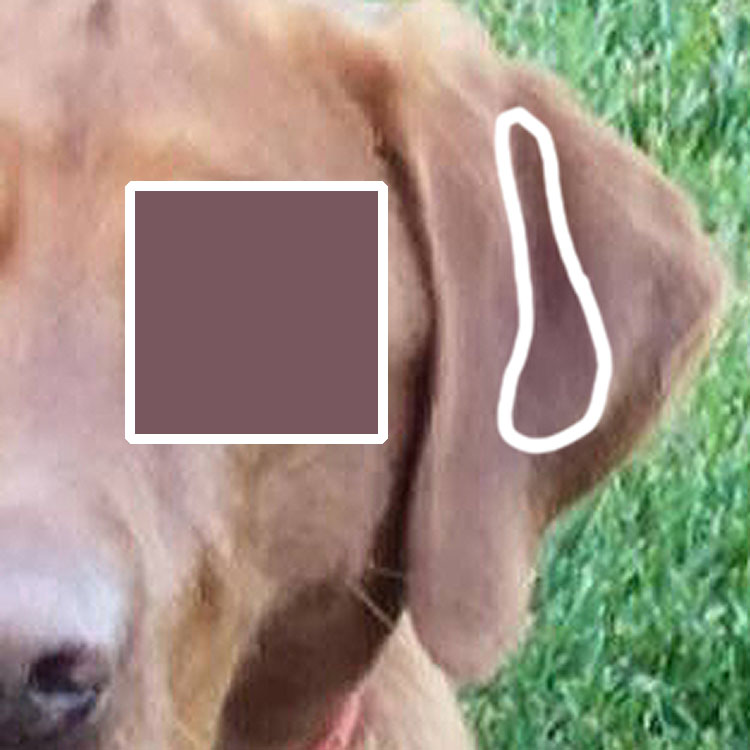
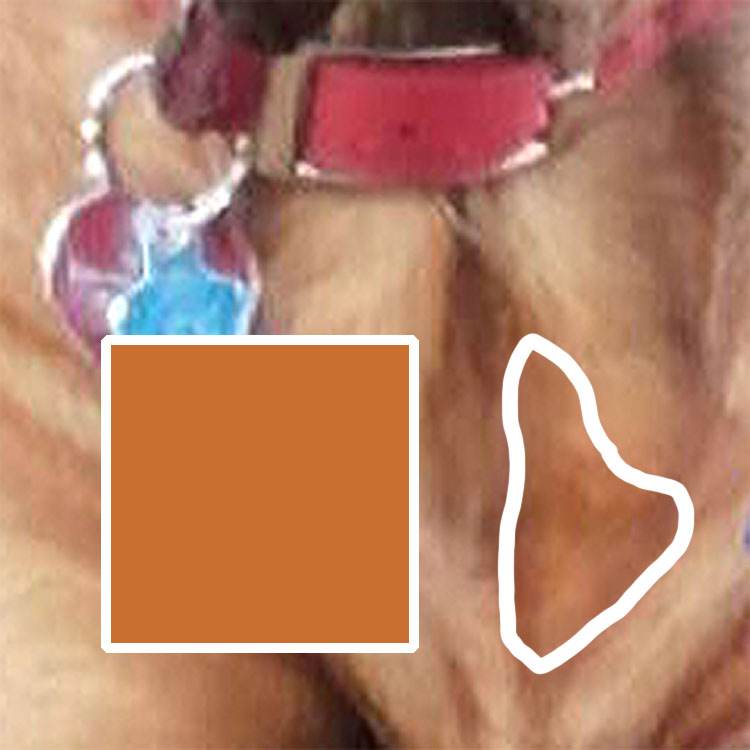
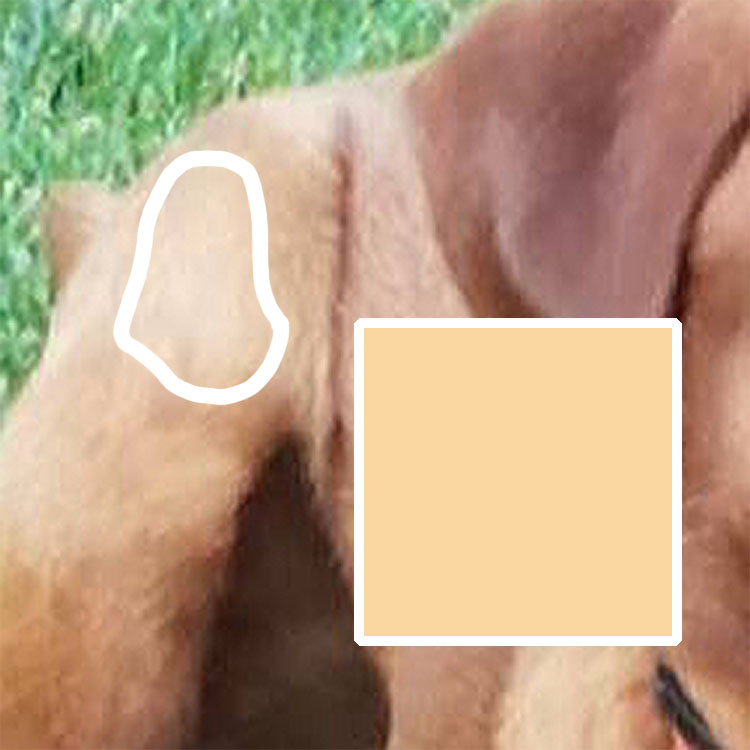
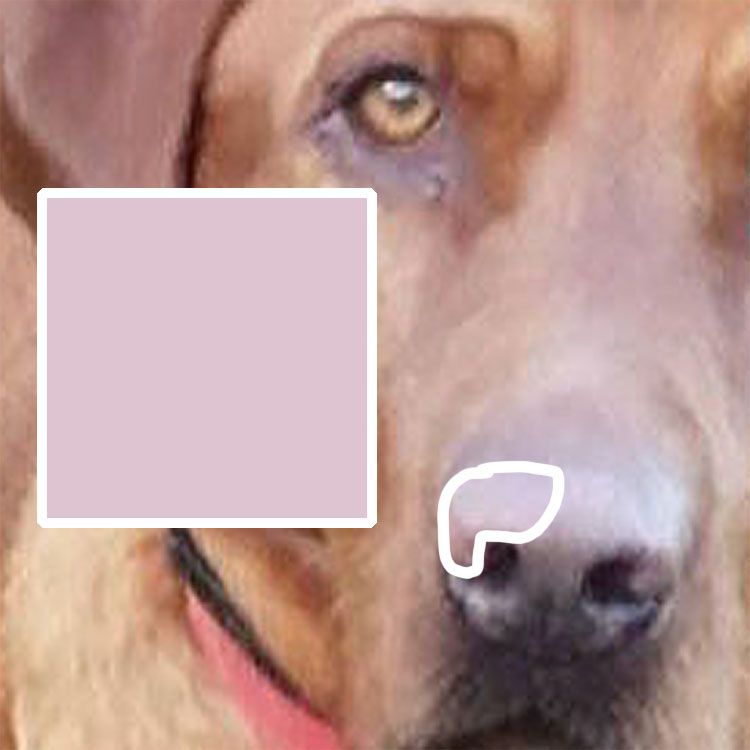
Because fabric collage is art, once you see these colors one can make the conscious choice to not only replicate the colors but to accentuate them, to push the colors further, into stronger purples, oranges, yellows, and pinks.
Or not. It’s the artist’s choice.
But in order to make the decision of whether to use brighter colors, one has to see that they are there to begin with.
An artist does not merely look. An artist sees.
Live Online Class Testimonials
“Taking the class helped me significantly advance my confidence with collage and my skill in executing my vision. Susan is a gifted teacher and she and Tom have created an excellent online learning experience.” —Joan M.
“Susan is a wonderful teacher with a gentle, encouraging style that encourages and guides students to create work that is their own. She has an uncanny knack for seeing the smallest correction to drawing, fabric, or design and to demonstrate with annotations on the screen how and where changes are needed. With screenshots of this annotated feedback, we moved forward with clear understanding of what was needed to create our projects. I got far more accomplished during this week than I thought possible.” —Judy N.
“I also liked the fact that I could work many more hours of the day. That would not have been possible attending an in-person class. I loved the freedom of working and doing other necessary things as needed throughout the day.” —Jan A.
“I’m sure we all got more of Susan’s individual time under this format. It was less expensive than paying for travel and lodgings and food on top of the class fee. It was key that we could go back to our fabric stash whenever we needed to. We had all the supplies we needed at our finger tips, and didn’t have to worry about what we had forgotten to pack.” —Nancy G.
“I loved the breakout rooms! I really enjoyed getting to know my fellow students in the smaller setting.” —Sandy L.
“In some ways I prefer the online class. Relationships are a huge part of a class; on the other hand, you’re never going to be best friends with the entire group and being comfortable in your own home made a huge difference in my comfort level.” —Mary M.
“I was particularly impressed that Susan and Tom called me the week before class to make sure I would have all I needed for the technical part of the class and then the personal Zoom meeting with Susan beforehand to make certain that I had a good pattern for my class piece before the course began. We were all ready from Day One to get the most out of the course as possible!” —Marie W.

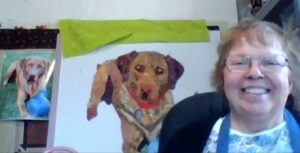
This is a wonderful post! I am anxious to try the photoshop color match idea. I just had shoulder surgery so this will give me a skill to work on while i have my arm in the sling. Thanks Susan and Tom!
Thank you Susan for opening my eyes to SEEING and not just looking! Your teaching and insights are priceless. Tom’s input is valuable, too. I find myself seeing nature and my surroundings and not just looking at them.
Thank you again. Have a wonderful day. ????.
Nancy
This was such a great class! Also I loved Michele’s project and her obvious enthusiasm. Susan, you are a supportive, gifted teacher and I encourage everyone to try a class. It is well worth the time and effort!
Nancy H
Thank you for this excellent post. I also have trouble seeing those extra colors, so this was very helpful. You and Tom are quite the team, constantly teaching.
This is similar to a painting/sketching instructor’s hint to turn the picture sideways or even upside down to SEE what is actually there, not what you think it is.
Excellent post, now, I am starting to understand the meaning of ‘seeing’,I must admit that Tom’s idea of showing us in this way, really opened my eyes, to the difference between the words ‘seeing and looking’. Thank you both for these clear explanations on the part of all your collage fans.